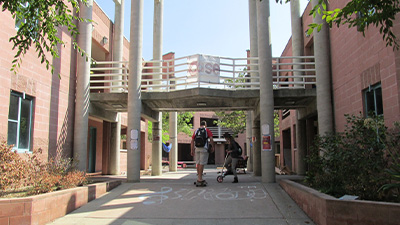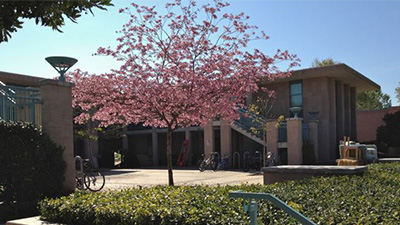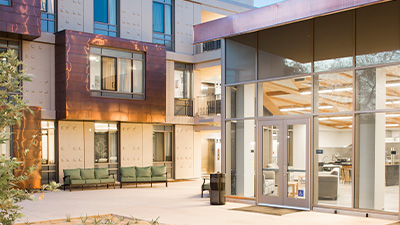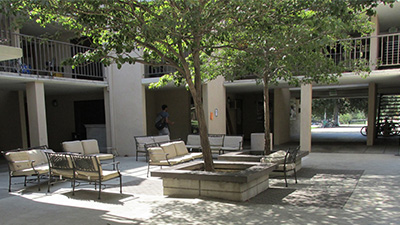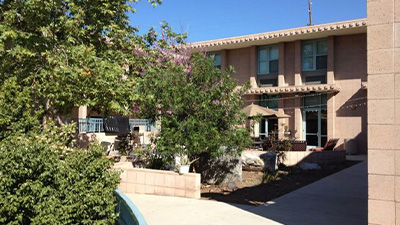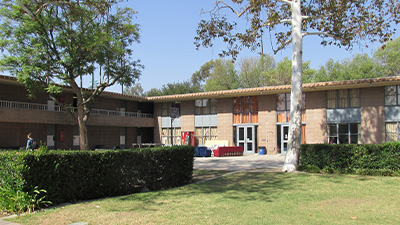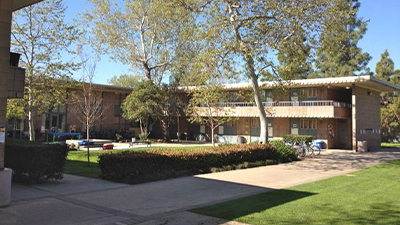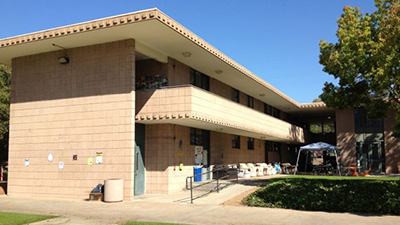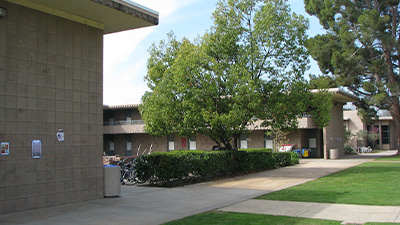There are nine residence halls on campus, each classified as either an “inner dorm” or an “outer dorm.” Most of the residence halls have unique legacy suites, many of which are responsible for playing music. The inner dorms are all U-shaped around a courtyard, with the lounge located in the center of the residence hall. Rooms are organized by suites, commonly two rooms that open out to the courtyard connected by a bathroom. The residents commonly socialize in the courtyard and lounge.
The outer dorms are newer and are generally arranged in a more classic suite style. Four to nine students live in singles, doubles and triples, sharing a common suite lounge and bathroom. The outer dorms tend to socialize by suite, but many do socialize in the hall lounges. No matter the location, each residence hall at Mudd has its own distinct culture. The Campus Map shows each residence hall location.
Room Draw Guide
Room draw takes place each year in the weeks following spring break. Room draw regulations are decided and voted on by Residence Hall Affairs Committee (DAC) in late fall/early spring and announced via the all-campus mailing list (Students-l). All room draw information is located on the Sakai Roster site under the current years folder.
Floor Plans
Complete floor charts for all residence halls as well as locations of off-campus apartments at Arrow Vista can be found on the Sakai Roster site. You can see pictures of rooms via this link. These rooms are typically assigned to first year students. Please note that the configuration of each room may be slightly different.
Roster
The student roster published each semester and is located on the Sakai Roster site. The roster includes student’s names, residence halls, cell phone numbers and emails.
Housing Agreement
Housing Agreement 2023–2024 Academic Year
Each Harvey Mudd student living on campus is required to read and sign the housing agreement.
Please note: Students will need to be logged into Symplicty to be able to sign the housing contract. Instructions for Housing Agreement 2023-2024 Academic Year.
Students who will be under 18 at the time of move-in will need to have a parent sign a paper version of the contract before the end of Orientation. Questions should be directed to the Division of Student Affairs office 909.621.8125 or ksandoval@hmc.edu.
Summer Housing
Summer housing is available on campus for students that are participating in a summer programs or research at Mudd. Summer housing and Summer Room Draw is managed by the Office Housing and Residential Life.
Work Orders
Facilities and Maintenance handles work orders for repairs needed in the residence halls.
Floor Charts
At the Room Draw website, you’ll find a floor plan for each floor in every residence hall. These charts give the approximate sizes and configurations of the various rooms on campus. The yellow highlights represent spaces reserved for you.
Room Size
In the chart above, we provided the approximate square footage of residence hall rooms by type and location. Most student residence hall rooms will remain carpeted for the upcoming school year, with the exception of Drinkward and certain suites in Linde. At the moment, the school is working on de-carpeting all the residence halls.
Furniture
At Mudd, every student is provided with a bed, mattress, dresser, closet, desk and desk chair. Some rooms have bookshelves, and others may have a cushy chair, as well. It is up to the occupant to provide additional furniture.
Extra stuff: Furniture from Overstock.com. (Use coupon code 121728 for 10 percent off.)
Lighting
All rooms have a strong overhead light. We do allow halogen lamps—as long as they’re used carefully to prevent fire. A desk lamp and bedside reading lamp may also be useful.
Air Conditioning
Every residence hall on campus has built-in air conditioning.
Refrigerators
You can bring a refrigerator, but it should be small and energy efficient. If you’d like to purchase one after you arrive, or order it for pickup, the following stores are within three miles of campus:
- Best Buy (Central Ave. and Eighth St. in Montclair)
- Walmart (Foothill Blvd. and Benson Ave. in Upland)
- Staples (Foothill Blvd. and Towne Ave. in Pomona)
- Home Depot (Mountain Ave. and Eighth St. in Upland)
Microfridge is a company that sells a combined microwave and refrigerator unit, which can be purchased directly by calling 800.994.0165. Harvey Mudd no longer participates in their rental program. It is much cheaper to buy the unit and keep it for all four years—and even sell or bequeath it to another student when you graduate.
Finally, you might consider splitting the cost of a refrigerator with your roommate. We suggest checking with him or her before arrival. Fridges can often be bought during residence hall auctions, held within the first couple weeks of school.
Microwaves and Other Cooking Appliances
Students may use microwaves in their rooms. Hot pots with automatic turn-offs, popcorn poppers and even toaster ovens, used safely, are also permitted. Hot plates with open coils, though, are not allowed in the residence halls (along with anything else with an open flame or coil). There are communal kitchens available for student use in South, Case, Drinkward, and Linde. These have refrigerators, freezers, stove tops and ovens, along with cupboard and counter space.
Sheets
All residence hall mattresses at Harvey Mudd College require twin-sized, “extra long” sheets. Regular twin sheets will not fit on the mattresses. Blankets and/or comforters that are machine washable are recommended.
Bed, Bath & Beyond has an entire line of sheets for residence hall beds available in extra long, along with lots of other useful items for residence hall rooms. Their closest location is at Ontario Mills Mall, about 10 miles east on the I-10. Target (located less than 3 miles away) also have a lot of bedding available.
Online, Uparents.com and Dormbuys.com have sets of extra long sheets, along with plenty of other useful residence hall items.
You can find these sheets many places in addition to our suggested retailers. Keep in mind there may be limited supplies of extra long sheets in the Claremont area around Orientation.
Electricity
Power outages can occur. Bringing a battery-powered alarm clock as a backup to your electric clock-radio may be a good idea. Flashlights are recommended for residence hall rooms, too. Candles are not allowed in the residence halls.
Phones, Answering Machines and Cell Phones
The College provides a telephone hook-up in each room, but not a telephone. Keep in mind that electric cordless phones don’t work during a power outage. Consider the possibility of a regular hard-wired phone, at least as a reserve. Since we have a central voice mail system, an in-room answering machine is not essential—though our voice mail system can get temperamental at times. Since you only need one phone/answering machine per room, we suggest checking in with your roommate before arrival to work out who will bring it.
Many students will have cell phones, and there are plenty of carrier options. Sprint has a transmission tower on our Sprague Library and gets good reception around most of campus. Some carriers will have signup tables at the Huntley Bookstore during Orientation.
Thrift Stores
Don’t want to invest in furniture? Go on thrift store runs with upperclass students after you arrive. There is plenty of good, cheap furniture to be found at a multitude of nearby thrift stores.
Cars and Parking
Freshman or first-year students are not allowed to bring automobiles, as Harvey Mudd College is unable to accommodate additional parking.
If you have questions or concerns, please contact Dean Chris Sundberg at 909.621.8757 or chris_sundberg@hmc.edu.
Bikes and Bike Locks
Harvey Mudd is a bicycle-friendly campus, as are the rest of The Claremont Colleges. Bikes are particularly convenient for getting to classes on other campuses. There are bike racks at each residence hall, as well as near the academic buildings’ entrances. However, bikes are often targeted for theft. Investing in a solid-steel, keyed U-Lock is essential, as thieves often employ bolt cutters.
Whenever possible, storing your bike in your room is the safest place.
Storage
During the academic year, personal storage is not available for students on campus.
For the summer, we encourage students to take everything home with them. If you need assistance with storage, ASCHMC (student government) provides subsidized off-campus storage options. Storage pods are taken off-site and locked over the summer, with no entry allowed.
To increase security and reduce the need to rent expensive storage pods, students should (perhaps in groups) rent space in the multitude of mini-storage locations near campus. Some even provide free truck use.
Maintenance
There is one building attendant assigned to each residence hall. Suite and communal bathrooms are cleaned weekly. Lounges and courtyards are cleaned daily.
The Office of Facilities and Maintenance (F&M) is here to assist students in a variety of ways.In addition to cleaning services, the department also handles maintenance and repair of residence hall facilities, key and card swipe access, room reservations, summer housing and grounds services. The F&M offices are located in the basement of the Platt Center.
The “What to Bring” List
The following is a suggested list of items to bring. A (*) denotes optional items, while a (#) denotes things you should contact your roommate about before arrival.
- Bed sheets, extra long twin (regular twin sheets will not fit on the mattresses)
- Blankets and/or comforter (machine washable is recommended)
- Pillow
- Towels
- Toiletries
- Trash can (metal ones won’t burn if something catches fire in it)
- Alarm clock (battery powered and electric)
- Flashlight
- Calculator
- Backpack/book bag
- Laundry basket
- Laundry detergent
- Quarters (for laundry: 1 dollar per wash, 50 cents for 45 minutes of drying)
- Duct tape (it fixes everything, but don’t use it on walls, ceilings or carpet or it will damage them)
- Phone (not a cordless one, since it will not be functional in a power outage) #
- Speakers *#
- Microwave/Toaster/Coffee Machine/Water Heater *#
- Small refrigerator *#
- Small fan (besides increasing air flow, fans provide “white noise” for sleep) *#
- Iron/ironing board (our advice: befriend someone in ROTC instead) *#
- Silverware and a couple unbreakable dishes
- Computer (see Computing and Information Services for help)
- Camera
- Power strip
- Dictionary/thesaurus
- Decor for the room
- Shelves, milk crates and so forth
- Desk light (fluorescent and compact fluorescent lights are more energy efficient)
- Sports/hobby equipment
- Bike/skateboard/longboard/unicycle/freelines/scooter*
If you decide to work you will need official identification. Most students use a state photo ID and their Social Security card or a valid passport. Some other forms of ID may be accepted, as well.
We think that’s about it! But don’t worry if you forget something. During Orientation, there will be time set aside for trips to Walmart, Target and Staples.
